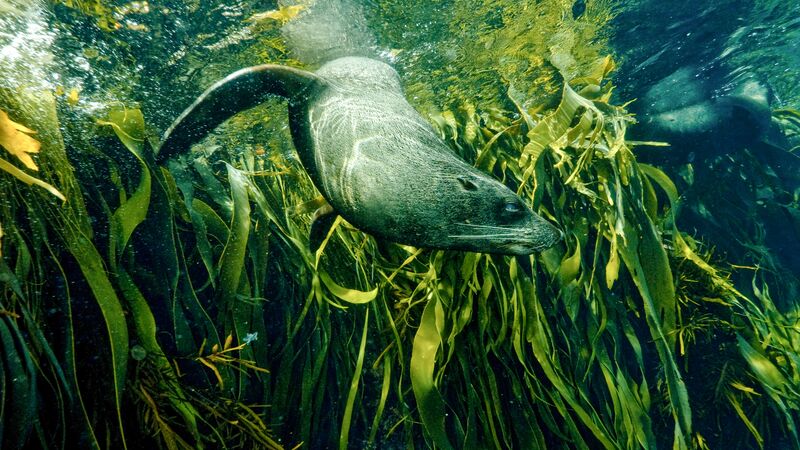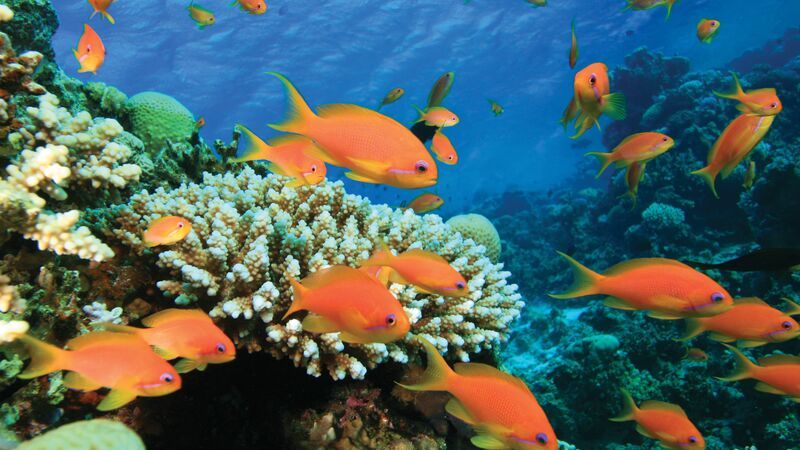A deep inhale as the water swells and curls forward; you push your face into the icy blue.
Emerging triumphant on the other side, your head buoys on the surface, away from the foam that crawls onto shore. It retreats back with the pull of the tide, the current rushes beneath your legs. The deep ocean is full of unknowns, but you feel at peace until – something slimy brushes your foot, then wraps around your calf. You flail and kick at what could be an eel, or a jellyfish, or some monstrous creature you’ve dreamt up. It comes to the surface: a massive, greenish-brown tangle of seaweed.
A nuisance to swimmers, surfers, divers and some beachgoers who can’t stand the briny smell, seaweed is the unlikely hero of climate change. But it’s making waves as game-changing solution for our warming planet. Here’s how.
Seaweed is bringing the ocean back to basic
Although humans have caused levels of carbon dioxide (CO2) to climb relentlessly, oceans have actually slowed the rate of climate change by absorbing a large amount of it. But as the ocean takes up CO2, it gets more and more acidic. Doesn’t sound good? That’s because it isn’t. Shells and skeletons of marine life can’t form – and sometimes dissolve – with high acidity. Here’s where our hero, seaweed, comes in. Much like its land-based relatives, seaweed uses carbon dioxide to do its photosynthesis-thing. Since it ‘breathes’ underwater, that CO2 gets pulled out of the ocean, helping to deacidify it. And the more that’s pulled from the ocean, the more can be taken out of the atmosphere.
RELATED: INTREPID’S CO-FOUNDER ON HOW YOU CAN STOP CLIMATE CHANGE RUINING TRAVEL
Plants can eat it, and so can we
Sushi lovers: this is your time to shine. Vitamins, high-quality protein, those omega-3 fatty acids you’re always hearing about – seaweed has it all. Declared a sustainable food hero, seaweed can provide important nutrients to the masses with just a tiny ecological footprint. Because seaweed can grow up to sixty times faster than plants on land, it’s one of the best food sources for our growing populations to rely on. And if you’re not a fan of the salty, umami taste of seaweed, not to worry. It’s also an organic fertiliser with all the minerals and trace elements to help your favourite plants thrive.
With oceans heating up, seaweed is keeping its cool
 The steady rise in ocean temperatures – at double the rate in the last half-century – is definitely raising eyebrows. Thickets of deep green fronds used to be strongholds of biodiversity off Australia’s coastlines, but warming oceans have left only five per cent of the iconic kelp forests intact. Higher temperatures have affected more than the ecosystem; curious divers and ocean-loving travellers are losing marine hotspots to visit. With new solutions to restore them, like Marine Permaculture Arrays (MPs), technology can help pump cooler ocean water to the surface and restore natural circulation. Along with the Climate Foundation and the University of Tasmania, The Intrepid Foundation is supporting an initiative to regenerate kelp forests, cooling waters in the process. Not only do the MPs help seaweed thrive, they also prevent coral bleaching and temper marine heat waves. It’s a win-win-win.
The steady rise in ocean temperatures – at double the rate in the last half-century – is definitely raising eyebrows. Thickets of deep green fronds used to be strongholds of biodiversity off Australia’s coastlines, but warming oceans have left only five per cent of the iconic kelp forests intact. Higher temperatures have affected more than the ecosystem; curious divers and ocean-loving travellers are losing marine hotspots to visit. With new solutions to restore them, like Marine Permaculture Arrays (MPs), technology can help pump cooler ocean water to the surface and restore natural circulation. Along with the Climate Foundation and the University of Tasmania, The Intrepid Foundation is supporting an initiative to regenerate kelp forests, cooling waters in the process. Not only do the MPs help seaweed thrive, they also prevent coral bleaching and temper marine heat waves. It’s a win-win-win.
SUBSCRIBE TO INTREPID’S NEWSLETTER FOR INSPIRATIONAL STORIES, TRAVEL TIPS, AND GIVEAWAYS
It reduces our four-legged pals’ emissions, too
Around the world, livestock accounts for nearly 15 per cent of human-driven greenhouse gas emissions. Animals like sheep and cattle give off a whole lot of methane when they, well, digest. Most farmers feed them grass and grains, but what happens when you try giving livestock seaweed?
It turns out they produce significantly less methane: supplementing cattle and sheep’s feed with less than one per cent seaweed reduces emissions by 60 per cent. In some cases, that number can be even higher. A bit of surf and turf can go a long way.
READ MORE: 8 YEARS OF CARBON NEUTRAL – THIS IS HOW INTREPID OFFSETS YOUR TRIP
It can be a sustainable livelihood for coastal communities
While seaweed isn’t more than a slippery pest for many, millions of people depend on the marine plant for their livelihoods. Next time you pick up your favourite ice cream or pasta, check the label for carrageenan. It’s what helps things like toothpaste, shampoo, and medications stick together, and its popularity as a vegan alternative to gelatin has made it a must-watch ingredient. Together with the growing demand for food and feed, seaweed’s other uses are expected to expand the market to unbelievable levels: 22.13 billion USD by 2024. Without the need for fresh water, fertiliser, or large plots of land, farming seaweed is a more sustainable alternative that can still generate an income. If we shift away from land-grown crops and fishing to seaweed, we can drastically reduce the impact our consumption has on the planet.
We can’t ignore climate change. If we do, who will face the worst of it? The generations to come deserve a planet where things are changing for the better. There is still a chance to slow down and even reverse some of the impact, but action has to start now. And as it turns out, seaweed could be the hero just beneath our feet all along.
Learn more about the slimy solution to climate change.
The Intrepid Foundation is the not-for-profit arm of Intrepid Group helping travellers give back to the places they visit. Since 2002, the Foundation has raised more than 7.5 million dollars for over 125 organisations around the world. From empowering vulnerable youth to helping refugees get back on their feet, The Intrepid Foundation supports life-changing projects that make places better to travel to and live in.
Hero image by Igor Kruglikov via Shutterstock.





